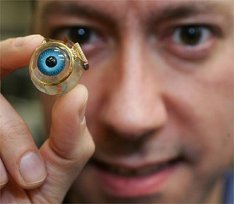Tietokone magazine reported on consumer electronics news among which
video glasses caught my eye, so to speak.
Sony's executive Howard Stinger and Tom Hanks presented the company's new gadgetry, including video eyewear.
Tietokone readers pointed out that although the report seems to claim otherwise, Sony isn't really the first one to present such equipment. Video glasses have been around for some years now and are sold online (see e.g.
Verkkokauppa store in Finland and Zeiss'
page).
 Hanks, Stinger and videogoggles (pic source here).
Hanks, Stinger and videogoggles (pic source here).
 Sony's video goggles
Sony's video goggles got me thinking about the not so fresh innovation of Sony
Walkman (released 1979), or the "Ear Patch Stereos" as they were literally called in Finland. What a technocultural innovation they were! Music that you could take with you and listen to just by yourself! One should remember that hundred years ago music was mainly a collective thing to do. Actually, since the beginning of music
itself, people have gathered
together to
do music - sing together around the fire, in working groups, sorrowful mourning parties, or, more lately in history, gathered together to enoy professional
live music performance, and so on.
 Then came the record player
Then came the record player which better enabled the
production of music. The song could now be refined, remade, patched together from separate sections to form a piece best reflecting the vision of its maker (singer, player, song-writer, producer). One could enjoy music without knowing how to sing or having someone to sing for them. One could just listen to records or radio at home with closest friends. With
headphones one could enjoy the records by the record player just by oneself.
Finally, Sony Walkman was invented and you could take the music with you where ever you went, and be isolated from your surroundings while being mobile....
...and listen to the music a billion dollar industry had meticulously produced to suit your taste and cultural niche.
The evolution of music tech has developed from enhancing group cohesion to individual isolation. It is one of the many common denominators of a group of individuals sharing same sort of cultural, social and esthetic values. Perhaps nowadays one listens to MP3s in isolation but still feeling connected to peers.
Video glasses are another interesting step in the technological evolution. Now that we have appliances like
Nintendo Wii or the like, it won't be long when we can enjoy a walk in the park with friends and not get out of the bed or the couch. We can be physically more isolated but virtually more social and collective.
 Imagine a bit more distant future
Imagine a bit more distant future, when gadgets like the Walkman (MP3-player) or video goggles become so tiny that they fit inside your eye and ear. Or, to a lot more scifi here, are implanted in your brain. Then
virtual would become
real (if it isn't already) and
physical something as irrelevant as atoms and molecules of a DVD disc of TV screen are today in enjoying a movie.
Pic sources: Sony Walkman from Erlingsi's Flickr page, gramophone from Design Boom, the future eye implant from Übergizmo.

 Add a GPS, some RFID and/or 3G technology and a video camera on the thing and multiply it to a few hundred tiny cyborgs using crowd intelligence and we'll have one efficient spy machine similar to the spider robot of Minority Report but half organic. If the cockroaches get really smart we might have one interesting YouTube channel.
Add a GPS, some RFID and/or 3G technology and a video camera on the thing and multiply it to a few hundred tiny cyborgs using crowd intelligence and we'll have one efficient spy machine similar to the spider robot of Minority Report but half organic. If the cockroaches get really smart we might have one interesting YouTube channel. 











